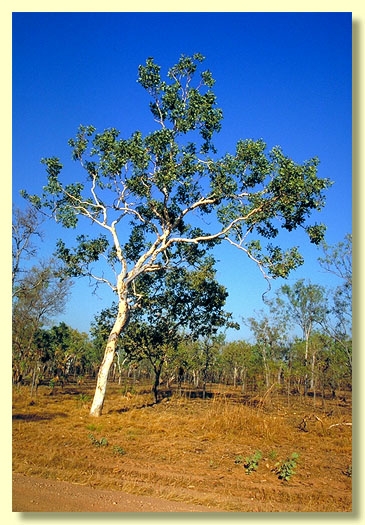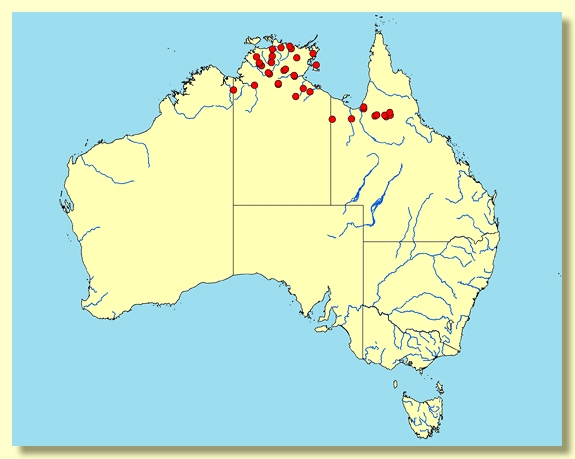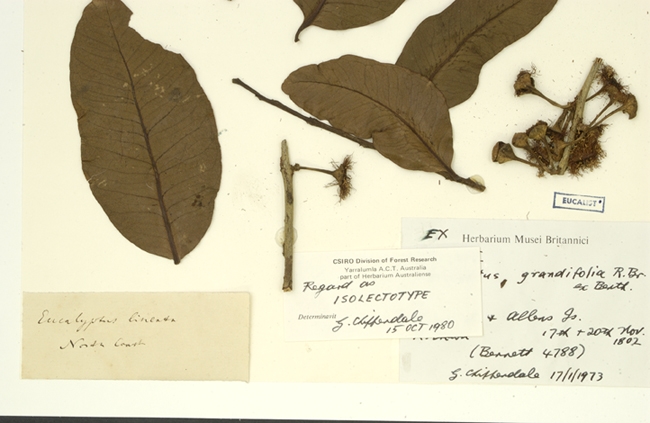Euclid - Online edition
Corymbia grandifolia subsp. grandifolia
Corymbia | Blakearia
Corymbia grandifolia (R.Br. ex Benth.) K.D.Hill & L.A.S.Johnson, Telopea 6: 457 (1995) subsp. grandifolia.
Tree 20 m tall, deciduous in the dry season. Forming a lignotuber.
Bark smooth, white to pale grey, shedding in thin flakes.
Branchlets lack oil glands in the pith; usually smooth but newest branchlets may be sparsely setose with bristle-glands.
Juvenile growth (coppice or field seedlings to 50 cm): stems rounded in cross-section, setose with bristle-glands at least in the lower part; juvenile leaves always petiolate, opposite or becoming alternate, ovate to broadly elliptical to rounded, 13–17 cm long, 11–14 cm wide, base usually rounded to tapering, rarely lobed or truncate, green, setose with bristle-glands or at upper nodes becoming glabrous.
Adult leaves alternate or opposite, petioles 0.5–1.6(2) cm long; blade elliptic-oblong to ovate-lanceolate, (6.8)8–20 cm long, 3–8.5(10.5) cm wide, undulate, base rounded to tapering, margin entire or distantly and irregularly scalloped, apex usually pointed, less commomly rounded, concolorous, glossy, green, glabrous, side-veins at greater than 45° to midrib, reticulation very dense, intramarginal vein present, oil glands small, island, or obscure.
Inflorescence borne on now leafless branchlets below new season’s growth, axillary compound, appearing congested with the basal internode only ca 0.4 cm long and peduncles 0–0.2 cm long, buds 3 or 7 per umbel, strongly pedicellate (pedicels 0.8–2.5 cm). Mature buds pyriform, 1–1.2 cm long, 0.7–0.9 cm wide, scar present (outer operculum shed early), operculum shallowly rounded, sometimes coarsely apiculate to umbonate, stamens inflexed, all fertile, anthers oblong, dorsifixed, versatile, dehiscing by longitudinal slits, style long and straight, stigma tapered, locules 3, the ovules not arranged in distinct vertical rows on the placentae. Flowers creamy white.
Fruit pedicellate (pedicels 0.7–2.6 cm long), cupular to cylindrical or sometimes urceolate with rim slightly flared above a constriction, 1–1.7 cm long, 0.8–1.4 cm wide, disc descending vertically, valves 3, enclosed.
Seeds brown, 4–7 mm long, saucer-shaped, smooth, hilum ventral.
Cultivated seedlings (measured at ca node 10): cotyledons large, orbicular to reniform; stems rounded in cross-section, densely setose with long bristle-glands; leaves at least shortly petiolate (petioles to 0.8 cm), opposite for at least 12+ nodes or becoming alternate by node 9, ovate to elliptic, 5.2–8.5 cm long, 2.3–4 cm wide, base rounded or tapering, apex rounded or pointed, dull, green, setose with bristle-glands on both sides, mainly restricted to midrib, sparse elsewhere.
Flowering has been recorded in January, October and November.
Corymbia grandifolia is a ghost gum tree species distributed from the Mitchell Plateau and central Kimberley region of Western Australia east through the Top End of the Northern Territory, including Bathurst and Melville Islands, to the Gulf Country of Queensland as far east as the Gilbert River. It occurs in monsoonal savannah woodlands on ± level sites or low sites in undulating terrain, on a variety of soil types but always with slightly impeded drainage. It characteristically has a smooth whitish trunk, lacks rough bark, and has a glossy large-leaved crown that is deciduous in the dry season.
There are three subspecies primarily separated by crown leaf features and pedicel length:
C. grandifolia subsp. grandifolia
Distinguished from the other subspecies by having elliptic-oblong to ovate-lanceolate glabrous crown leaves that are rounded or tapering at the base, relatively short petioles 0.5–2 cm long and buds with pedicels 0.8-2.5 cm long when mature.
Found in wetter and also somewhat drier parts of the monsoonal Top End of the Northern Territory east from Maningrida in northern Arnhem Land, Pine Creek and Katherine, through the Gulf of Carpentaria hinterland to Normanton and the Gilbert River near Forsayth in Queensland, occurring also on Groote Eylandt and Allan and Sweers Islands in the Gulf. It is the only subspecies that occurs in Queensland.
C. grandifolia subsp. longa
Has petioles 0.9–3.3 cm long, pedicels of mature buds 1.9–3.7 cm long, and fruit that are usually longer and more consistently urceolate than the other two subspecies. Leaves are predominantly ovate-elliptic and glabrous.
Occurs from Wyndham and Kununurra in Western Australia, east into sub-coastal areas of the Top End of the Northern Territory west of the Stuart Highway, to Adelaide River, Manton River and Oenpelli, and also on Bathurst and Melville Islands.
C. grandifolia subsp. lamprocardia
Distinguished by the crown leaves, which are predominantly deltoid to cordate, i.e. broad with truncate or lobed bases, and widest in the basal third of the lamina. The lamina is frequently sparsely setose or sandpapery, which makes it appear less glossy than the other subspecies. The petioles, pedicels and fruit generally overlap in length with those on specimens of the other subspecies, but are never as long as the longest petioles, pedicels and fruit of subsp. longa.
Distributed from the central Kimberley region, e.g. Inglis Gap, Adcock Gorge and Karunjie Station, east to the Carr Boyd Range and Kununurra, and Wyndham, extending east into the Northern Territory to between Willeroo and Katherine.
The subspecies sometimes overlap in some features. Specimens will not always be readily assigned to a subspecies, particularly those from the Mitchell Plateau.
C. grandifolia is one of the easiest ghost gum species to identify because of the smooth white trunk and large petiolate glossy green crown leaves. The species most likely to be confused with C. grandifolia is C. flavescens, which occurs in drier red soil plain country east from Port Hedland and Broome in Western Australia to Larrimah, Tennant Creek and the Barkly Tableland in the Northern Territory and Mount Isa in Queensland, i.e. just south of the range of C. grandifolia. The crown leaves of C. flavescens are not as conspicuously glossy but overlap in dimensions and shape with those of C. grandifolia subsp. grandifolia; pedicels of mature buds are shorter in C. flavescens (0.2–0.6 cm long) compared with those of C. grandifolia (always > 0.8 cm long in all subspecies). In the Top End of the Northern Territory glossy-leaved specimens of C. bella may be superficially confused with C. grandifolia subsp. longa but can be distinguished on inflorescence features, viz. C. bella has several obvious internodes in the expanded axillary inflorescence, whereas C. grandifolia subsp. longa only has a basal internode; also buds and pedicels are shorter and more gracile in C. bella. In the Kununurra to Timber Creek area of north-western Australia C. grandifolia subsp. lamprocardia may be confused with C. confertiflora, but can be distinguished by the following features: bark smooth, crown leaves ± glossy, strongly petiolate (petioles 0.7–2.5 cm long), and glabrous or only sparsely setose when fully formed. (C. confertiflora has a basal stocking of rough tessellated bark on the trunk and crown leaves dull, setose on both surfaces and sessile or shortly petiolate (petioles 0–0.5 cm long.))
MORE ABOUT CORYMBIA
MORE ABOUT GHOST GUMS
Corymbia grandifolia subsp. grandifolia: Latin grandis, of great stature and folium leaf, referring to the conspicuously large leaves.
subsp. lamprocardia: Greek lampros, shining and cardia heart, referring to the glossy, green, heart-shaped crown leaves.
subsp. longa: Latin longus, referring to the relatively longer petioles, pedicels and fruit, compared with the other subspecies.













